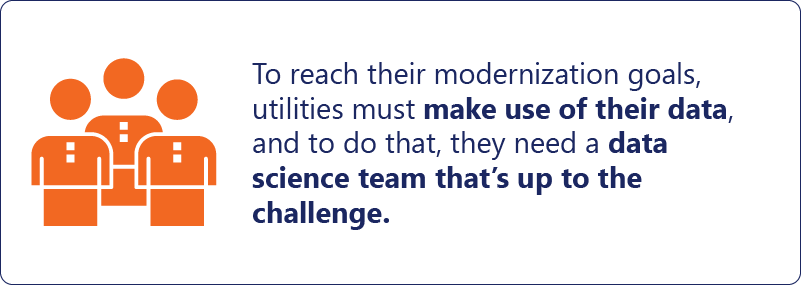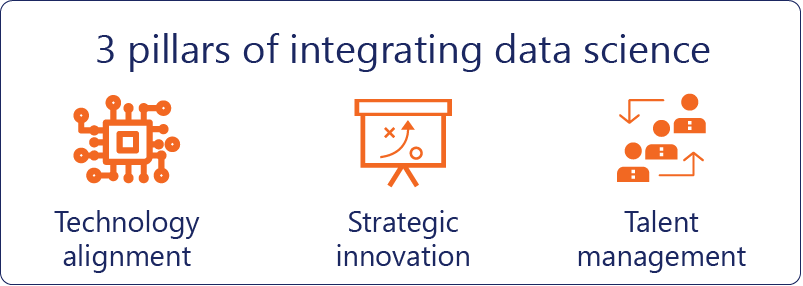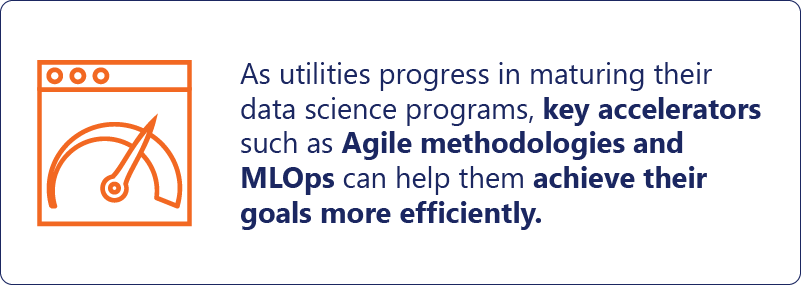5-minute read
Quick summary: How a well-planned data science roadmap can enable utilities to achieve their grid modernization goals—and realize additional benefits along the way
Faced with the challenges of an aging infrastructure, increased electrification, and the rise of distributed energy resources (DERs), utilities are on a mission to modernize their approach to grid investment and risk management. Modernization carries the promises of higher return on infrastructure investments, improved system safety and reliability, and reduced operating costs—if it’s approached strategically. To reach this goal, utilities must make use of their data, and to do that, they need a data science team that’s up to the challenge.
In this article, we’ll explore how different levels of analytics maturity drive data science capabilities to build higher levels of grid intelligence.

Caption
The Maturity Model
When we help utilities achieve grid intelligence, the first step is to identify the stage of an organization’s analytics maturity.
As any experienced traveler knows, the first step in planning a journey is to determine where you are right now. Setting out on the path to grid intelligence is more complicated than knowing longitude and latitude—it requires building a 360-degree picture of the present data ecosystem.
When we work with utilities to build current state assessments, we take a five-step approach to ensure that the result is accurate, thorough, and robust enough to serve as an effective foundation for their strategy:
1. Collect all relevant information about the current data ecosystem via surveys, documentation reviews, and interviews with stakeholders at all levels.
2. Assess the task at hand by creating an operating model of the desired data ecosystem, conducting a gap analysis between current state and future state, and developing a hypothesis for remediating the gaps.
3. Socialize the results of the assessment with stakeholders and collaborate on next steps.
4. Synthesize the data from steps 2 and 3 to build targeted solutions and recommendations.
5. Realize the initiative by laying out next steps in a roadmap encompassing people, processes, and technology to realize the desired enhancements.

Technology alignment
There’s no question that building data science capabilities requires an investment in technology. It’s equally important that technology solutions align with strategic objectives—that decision makers answer the question “Which business problem(s) will this solve?” before they configure their systems. Utilities that achieve this alignment will benefit from a stack of industry-best machine learning tools, solid and maintainable deployments, and a scalable machine learning operations (MLOps) infrastructure for solving enterprise problems.
Strategic innovation
If data science is going to deliver business value, a strategic approach to management and governance is essential. Utilities that successfully address the strategy and process aspects of building data science capabilities will have a vision for delivering value to the business, a system for adoption and prioritization planning, and an ecosystem for iterative development and delivery of data science solutions.
Talent management
While many organizations may overlook “the people side” of building data science capabilities, it’s no less important—possibly more so—than the other two pillars. Integrating data science into an organization requires retraining, retooling, and reskilling a workforce, and that’s where change management comes in.
Proven change management strategies help utilities ensure that team members understand their roles in achieving the goals of the data science initiative and how it benefits them personally and professionally. Utilities that have successfully addressed this talent management pillar benefit from skilled and domain-knowledgeable teams, training and goals that build up the capability, and a set of clear expectations, communications, and practices.

A mature analytics organization
By investing in these three pillars, an organization can move to the most mature level: achieving grid intelligence. In this final phase of the modernization roadmap, the organization reaches its goal, marked by specific achievements in three areas:
Strategy
• Efficiency and safety goals supported by predictive analytics
• Enriched, real-time operational decision making
Team
• Analytics community delivering enterprise-wide standards and results
• Governed, accessible analytics platform
Technology
• Growing catalog of high-quality data and reports
• Flexible cloud tools to meet future challenges
Accelerating your progress
As utilities progress in maturing their data science programs, certain key accelerators can help them achieve their goals more efficiently. For example, advancing from the legacy starting point to the “building organizational capabilities” phase can be accelerated by building out data governance process maps.
Other proven accelerators that successful utility companies focus on include:
• Migrating data to the cloud to ensure accessibility by authorized users
• Embracing Agile methodologies
• Implementing Machine Learning Operations (MLOps)
• Adopting a templated approach to utilities’ business use cases for analytics such as investment planning and computer vision

Achieving business results along the way
While the end goal of your roadmap is grid intelligence, utilities that make the journey discover additional business benefits along the way. Here are just a few examples:
• Begin at Legacy Operations: Ensuring accuracy in grid data; reducing cost of standard data requests
• Build Analytics Strength: Grid investment planning for future demand and profitability; improved reliability and maintenance efficiency
• Achieve Grid Intelligence: Management of emergency operations in real time; adoption of data-informed efficiencies across the business
A roadmap for the future
For utilities looking to develop the data science capabilities needed to achieve grid intelligence, the first step is to understand its current maturity level and build a roadmap for analytics growth. By growing their organization’s analytics maturity, they position themselves to address the challenges of today’s environment and become better prepared for whatever the future holds. Along the way, the supplemental business benefits can help them build a truly data-driven organization, where high-performance data ecosystems can drive every strategic decision and evolve as new challenges and capabilities arise.
Like what you see?

Adam Cornille is Senior Director of Advanced Analytics at Logic20/20. He is a data science manager and practitioner with over a decade of field experience, and has trained in development, statistics, and management practices. Adam currently heads the development of data science solutions and strategies for improving business maturity in the application of data.

